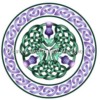
Hand embroidery has played a significant role in Celtic tradition for centuries. The intricate patterns and designs of Celtic embroidery are not only beautiful but are also steeped in symbolism and cultural meaning. In Celtic culture, embroidered clothing was a sign of wealth and status. Embroidery was used to decorate clothing such as tunics, cloaks, and kilts. The designs were often intricate and featured motifs such as spirals, knots, and interlaced patterns. Embroidery was also used to decorate religious artifacts such as vestments, altar cloths, and banners. These items were often adorned with symbols of the natural world, such as animals and plants, as well as religious symbols such as crosses and Celtic knots.
These emblems were also used to decorate household items such as tablecloths, napkins, and curtains. The designs on these items often featured motifs such as thistles, shamrocks, and Celtic knots. In Celtic culture this art was a way for women to practice and showcase their embroidery skills. The intricate designs and symbolic meanings of Celtic embroidery continue to be appreciated and admired by people around the world today.